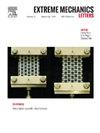Static and dynamic analysis of auxetic three-dimensional curved metamaterials in both axial and circumferential directions
IF 4.5
3区 工程技术
Q2 MATERIALS SCIENCE, MULTIDISCIPLINARY
引用次数: 0
Abstract
Metamaterials can enable unique mechanical properties based on their geometry rather than their chemical composition. Such properties can go beyond what is possible using conventional materials. Most of the existing literature consider metamaterials in Cartesian coordinates with zero curvature. However, realistic utilization of meta-structures is highly likely to involve a degree of curvature. In this paper, we study both the effective static and dynamic properties of metamaterials in the presence of curvature. To capture the effect of curvature on the static behavior of our metamaterial, we calculate the effective Poisson’s ratio of the metamaterial in the presence of curvature. We conduct our analysis on three-dimensional metamaterials with varying effective Poisson’s ratio. We observe a significant change in the values of the effective Poisson’s ratio of the metamaterial due to curvature. To capture the effect of curvature on the dynamics of our metamaterials, we calculate dispersion curves of curved metamaterial at different circumferential directions. We show both numerically and experimentally the change of the dynamic behavior of auxetic metamaterial from attenuation to transmission and vice-versa due to curvature. Our findings underscore the importance of curvature in both static and dynamic analysis of metamaterial design and could provide the means to guide practical implementations of metamaterials for functional use.

轴向和周向形变三维弯曲超材料的静力和动力分析
超材料可以根据其几何形状而不是化学成分来实现独特的机械性能。这样的性能可以超越使用传统材料的可能性。现有文献大多考虑零曲率笛卡尔坐标下的超材料。然而,元结构的实际应用很可能涉及一定程度的曲率。本文研究了曲率存在下超材料的有效静态和动态特性。为了捕捉曲率对我们的超材料的静态行为的影响,我们计算了曲率存在下的超材料的有效泊松比。我们对具有不同有效泊松比的三维超材料进行了分析。我们观察到由于曲率的影响,超材料的有效泊松比值发生了显著的变化。为了捕捉曲率对我们的超材料动力学的影响,我们计算了弯曲超材料在不同周向上的色散曲线。我们用数值和实验两种方法证明了由于曲率的影响,形变超材料的动力学行为从衰减到传输的变化,反之亦然。我们的研究结果强调了曲率在超材料设计的静态和动态分析中的重要性,并可以为指导超材料功能使用的实际实现提供手段。
本文章由计算机程序翻译,如有差异,请以英文原文为准。
求助全文
约1分钟内获得全文
求助全文
来源期刊

Extreme Mechanics Letters
Engineering-Mechanics of Materials
CiteScore
9.20
自引率
4.30%
发文量
179
审稿时长
45 days
期刊介绍:
Extreme Mechanics Letters (EML) enables rapid communication of research that highlights the role of mechanics in multi-disciplinary areas across materials science, physics, chemistry, biology, medicine and engineering. Emphasis is on the impact, depth and originality of new concepts, methods and observations at the forefront of applied sciences.
 求助内容:
求助内容: 应助结果提醒方式:
应助结果提醒方式:


